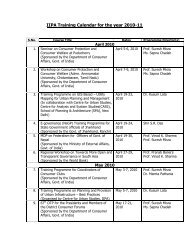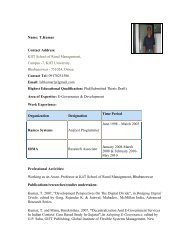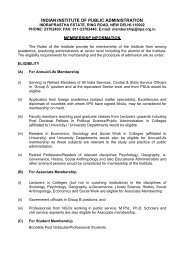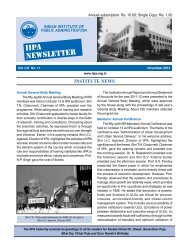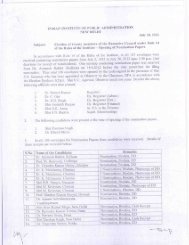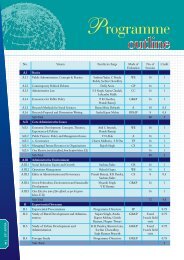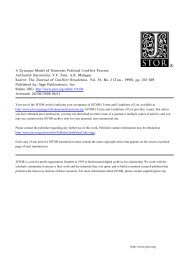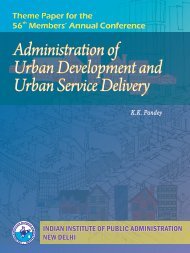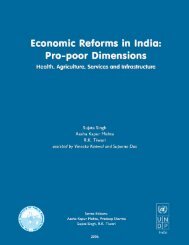Subcontracting and Economic - Indian Institute of Public Administration
Subcontracting and Economic - Indian Institute of Public Administration
Subcontracting and Economic - Indian Institute of Public Administration
You also want an ePaper? Increase the reach of your titles
YUMPU automatically turns print PDFs into web optimized ePapers that Google loves.
<strong>Subcontracting</strong> And <strong>Economic</strong> Reforms In India With Special Reference To Agro-based Industries In India<br />
4<br />
The Advantages <strong>of</strong> <strong>Subcontracting</strong><br />
In recent days, subcontracting or outsourcing is very <strong>of</strong>ten<br />
observed in different types <strong>of</strong> industry, including consumer<br />
durables, consumer non-durables <strong>and</strong> also in the capital<br />
goods sector. This section describes the principal reasons<br />
that encourage the evolution <strong>of</strong> the outsourcing relationship.<br />
Specialisation<br />
The basic theoretical reason behind the emergence <strong>of</strong> the<br />
outsourcing relationship, especially in the manufacturing<br />
industry, is the principle <strong>of</strong> division <strong>of</strong> labour <strong>and</strong><br />
specialisation. In the case <strong>of</strong> the divisible production process,<br />
subcontracting may help substantially to achieve economies<br />
<strong>of</strong> scale. It has been observed that new-sprung industries<br />
are more likely to be vertically integrated, that is,<br />
they prefer in-house activities rather than outsourcing. Yet,<br />
as the dem<strong>and</strong> for the product increases, the industries have<br />
a greater tendency to disintegrate the production process<br />
<strong>and</strong> to enter into a subcontracting relationship.<br />
From the above discussion, it can be observed that the<br />
specialisation phenomenon is facilitated by this outsourcing<br />
relationship. Specialisation subcontracting is commonly<br />
observed in Japan <strong>and</strong> North America (Ramaswamy, 1999).<br />
Labour Market Fragmentation<br />
In most <strong>of</strong> the developing economies the labour market is<br />
<strong>of</strong>ten segregated into two components, having opposite<br />
characteristics - organised labour market <strong>and</strong> unorganised<br />
labour market. In the organised labour market, the<br />
workers are well paid, governed by long-term contracts,<br />
subject to government regulations <strong>and</strong> trade union pressure.<br />
On the other h<strong>and</strong>, workers in the unorganised labour<br />
market, are low paid. There is no job security, nor pressure<br />
<strong>of</strong> trade union <strong>and</strong> government regulations on the health<br />
<strong>and</strong> safety <strong>of</strong> the employees. The unorganised sector is<br />
completely outside government patronage.<br />
This binary character <strong>of</strong> the labour market <strong>of</strong>ten encourages<br />
product subcontracting as well as employment subcontracting.<br />
The large unionised firms can utilise this vast<br />
informal labour market indirectly by giving the subcontract<br />
to a cluster <strong>of</strong> small firms, who have access to the<br />
unprotected labour supply at a cheap rate. The problem<br />
<strong>of</strong> the informal sector or the small firms is an insufficient<br />
supply <strong>of</strong> capital. The nuclear firm usually provides the<br />
technology <strong>and</strong> finance to the subcontractors. This<br />
outsourcing helps the principal firm to reduce its overhead<br />
costs <strong>and</strong> the bargaining power <strong>of</strong> the union. According<br />
to Deshp<strong>and</strong>e (1997), the trade unions noticed<br />
that their bargaining power has a negative correlation with<br />
the availability <strong>of</strong> the outsourcing relation to the management.<br />
In fact, Ramaswamy (1999) has also mentioned that<br />
some unorganised, but high wage business units may increase<br />
pr<strong>of</strong>it by farming out certain labour-intensive peripheral<br />
activities. <strong>Subcontracting</strong>, emerging due to the fragmented<br />
nature <strong>of</strong> the labour market is seen in the <strong>Indian</strong><br />
garment, shoe <strong>and</strong> electrical fan industries <strong>and</strong> in Japan.<br />
6




